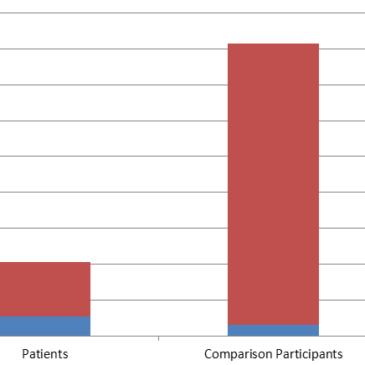Many studies have investigated comorbidity between substance use disorders and other mental health issues. In particular, some researchers
have studied possible associations between alcohol use disorder (AUD) and attempted and completed suicide in various populations (Conwell et al, 2000; Chiu et al., 2004). This week’s BASIS reviews a study that investigates this association in an elderly population in Western Sweden (Morin et al., 2012).
Methods
- The researchers targeted people 70 years or older who were admitted to a medical emergency department after a suicide attempt. One hundred thirty-three were invited to participate, and 103 (77%; 47 men) agreed to participate.
- The researchers selected comparison subjects from the Prospective Population Study of Women and the Gerontological and Geriatric Population Studies. They selected 4 comparison participants each for 99 patients and 3 comparison participants each for the remaining 4 patients, for a total of 408 controls.
- All participants completed a cognitive evaluation and an interview with a psychologist regarding current and previous alcohol consumption and any previous suicide attempts. For all participants, researchers reviewed medical records for evidence of AUD[1] and other previous episodes of mental illness.
- The patients also answered questions regarding physical health, symptoms of depression, circumstances at the time of the
suicide attempt, and psychiatric symptoms during the month prior to the suicide attempt. - The comparison participants answered questions about psychiatric symptoms during the month prior to the interview.
- The patients also answered questions regarding physical health, symptoms of depression, circumstances at the time of the
- Morin and his colleagues used logistic regression to compare lifetime AUD prevalence between the patient and comparison groups. In an additional multivariate model they controlled for histories of previous suicide attempts and/or psychiatric treatment.
Results
- Twenty six percent of those who had a hospital-treated suicide attempt had an AUD, while only four percent of those who did not have a hospital-treated suicide attempt had an AUD, OR = 10.5 95% Confidence Interval (CI) [4.97,22.53], p < .001 (see Figure).
- After controlling for previous suicide attempt and history of psychiatric treatment, the difference between the hospital-treated suicide attempt rates for those with AUD and without AUD remained significant, OR = 5.7, 95% CI [1.92,16.98], p < .01.

Figure. Number of people with and without alcohol use disorder, patients versus comparison participants (Morin et al., 2012). Click image to enlarge.
Limitations
- The patient group was recruited in emergency departments. As a result, the study did not include elderly people who attempted suicide but did not receive emergency department treatment.
- Given their circumstances, the patients may have been more open about problems with alcohol than the interviewees in the comparison group. They may have been less likely than comparison participants to underreport alcohol use disorders.
- It is not clear from the study whether the factors that led to the suicide attempt also led to alcohol use disorder, or if the alcohol use disorder led to the circumstances that resulted in the suicide attempt.
Conclusions
The results of this study suggest that within the elderly population, those with AUD are significantly more at risk for attempting suicide than those without AUD. Future studies will be necessary to determine the directions or mechanisms of causality between AUD and suicidal tendencies. Based on just the association, however, the authors recommend that clinicians who work with elderly patients evaluate these patients for alcohol use, depressive symptoms and suicidal feelings. Evidence of one of these risk factors (e.g., AUD) ought to lead to further screening for the others (e.g., depressive symptoms or suicidal feelings).
-Matthew Tom
What do you think? Please use the comment link below to provide feedback on this article.
References
Conwell, Y., Lyness, J.M., and Duberstein, P. (2000). Completed suicide among older patients in primary care practices: a controlled study. Journal of the American Geriatric Society. 48(1), 23-29.
Chiu, H.F.K. and Yip, P.S.F., Chi, I., et al. (2004). Elderly suicide in Hong Kong: a case-controlled psychological autopsy study. Acta Psychiatrica Scandinavica. 109 (4), 299-305.
Morin, J., Wiktorsson, S., Marlow, T., Olesen, P.J., Skoog, I., Waern, M. (2012). Alcohol use disorder in elderly suicide attempters: a comparison
study. American Journal of Geriatric Psychiatry, 2012 Apr 16, e-publication ahead of print.
Skoog, I. (2004). Psychiatric epidemiology of the old age: the H70 study – the NAPE lecture 2003. Acta Psychiatrica Scandinavica, 109 (1), 4-18.
Lissner, L., Skoog, I., Anderson, K., et al. (2003). Participation bias in longitudinal studies: experience from the Population Study of Women in
Gothenburg, Sweden. Scandanavian Journal of Primary Health Care, 21(4), 242-247.
Pfaff, J.J., Almeida, O.P., Witte, T.K., et al. (2007). Relationship between quantity and frequency of alcohol use and indices of suicidal behavior
in an elderly Australian sample. Suicide & Life Threatening Behavior, 37(6), 616-626.
[1] The researchers used a broad definition of AUD in accordance with DSM-IV. It included cases with social complications of problematic alcohol use, cases with physiological dependency, and cases with multiple admissions for detox treatment. Interviewees could be classified as having lifetime AUD based on either interviews or medical records.




